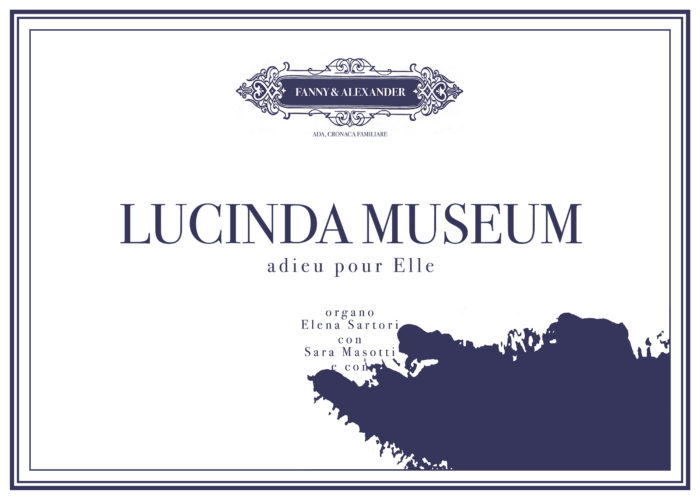Lucinda Museum
adieu pour Elle
- Concept: Luigi de Angelis, Chiara Lagani, Antonio Rinaldi
- Dramaturgy and costumes: Chiara Lagani
- Set and lighting design: Luigi de Angelis, Antonio Rinaldi
- Photohoroscope: Antonio Rinaldi
- Photographies: Enrico Fedrigoli
- Video images: Zapruder Filmmakersgroup
Lucette’s costume: BOBOUTIC - Direction: Luigi de Angelis
- Organ: Elena Sartori
- with: Sara Masotti, Marco Cavalcoli, Luigi de Angelis, Chiara Lagani
- Technical direction: Antonio Rinaldi
- Scenery and technical realization: Antonio Rinaldi with Melissa Cappelli, Elisa Eusebi, Francesca Gobbi, Elidio Bilanzuoli
- Tailoring: Laura Graziani Alta Moda
- With thanks to AHLBORN for the kind concession of the digital organ, the bar Barnum, Ravenna Teatro, Rodolfo Sacchettini, Sofia Vannini
Year : 2005
Poor L.
We are sorry you left so soon. We are even sorrier to have inveigled our Esmeralda and mermaid in a naughty prank. That sort of game will never be played again with you, darling firebird. We apollo. Remembrance, embers and membranes of beauty make artists and morons lose all self-control.
We wished to admire and amuse you, BOP (bird of paradise). We went too far. I, Van, went too far. We regret that shameful, though basically innocent scene. These are times of emotional stress and reconditioning.
Destroy and forget.
Tenderly yours A & V.
(in alphabetic order).
TOUR
June 23/24, 2006 | Turin, Festival delle Colline Torinesi, Cavallerizza Reale
November 24/25/26, 2005 | Ravenna, Galleria Ninapì
PRESS REVIEW
“A Museum for the Beloved Lucette,” Magda Poli, Il Corriere della Sera, September 3, 2006
For years, the “art workshop” company Fanny & Alexander has worked on Vladimir Nabokov’s 1969 novel Ada or Ardor, creating a fascinating sequence of performances—“dwellings” in which the story of the incestuous passion between Ada and Van unfolds, from early adolescence to their 80s. In this story, sex, time, and madness intertwine in both lofty and base forms, painting landscapes of the soul.
The mysterious and refined Lucinda Museum, created by Luigi De Angelis, Chiara Lagani, and Antonio Rinaldi, is a stop on this journey through a family chronicle that becomes a study on memory, life, and death. Enigmatic word games dismantle linguistic boundaries and build bridges between meanings.
Villa Lucinda is the small museum Van dedicates to his half-sister Lucette, who, realizing she could never have Van, took her own life by jumping from the ship where she had encountered him. In this intimate museum, among portraits and photographs, a large mirror opens to reveal a room with a bathtub where Lucette bathes. An organ plays Ligeti’s notes of quiet sorrow while Van and Ada appear in the background through a glass door—distant, complicit, and unreachable.
On the dark stage, words, letters, and enigmas of a death-tinged sentiment light up. The atmosphere evokes a plunge into oneself, sinking into the infinite end of Lucette. Trapped sensations fill the room, spied upon without shame, evoking a life that demands to be observed again in order to finally disappear. Lucette becomes a modern Eurydice, drawn not by darkness but by the light of knowledge.
“The Heartbreaking Solitude of Memory,” Alessandro Fogli, Il Corriere di Romagna, November 29, 2005
With Vaniada—set in the afterlife—Fanny & Alexander seemed to have perfected their multifaceted Ada, A Family Chronicle, an ineffable saga based on Vladimir Nabokov’s masterpiece Ada or Ardor, intricately woven with the myths of Eros and Thanatos. However, in this new (and seemingly final) Lucinda Museum, death—conceived, never portrayed—takes on a dual role as both the endpoint of existence and a catharsis for what remains.
Disrupting the timeline of Lucinda Veen’s suicide (Lucette, Ada’s younger sister, also in love with Van) that occurred in Ardis II, Fanny & Alexander reintroduce her sad specter in a bathtub—suggesting her ambiguous pre-adolescent liaison with Ada and Van, as well as her drowning—inside a bare, cold, dimly lit room. With her, in a poorly illuminated corner, stand the silent pseudo-phantoms of Ada and Van. This room witnesses Lucette’s bewilderment and pain, as well as the guilt and awareness of these enfants maudits, conveyed not through images or dramatic actions but through the haunting score of Ligeti’s Volumina, performed on the organ by Ada and Van. The evocative music underscores Lucette’s immense solitude, defeat, and resignation. She expresses her realization that she was drawn into a tragically dangerous game, without needing words.
Simultaneously, shadows and voices of a younger, passionate, and reckless Ada and Van emerge and writhe in an adjacent memory room. In a whirlwind of crazed recollection, they relive moments that, as now becomes terrifyingly clear, led Lucette to her fate. They also confront the painful awareness of their actions, confessing their madness in a “recollection” shared with Lucette.
It is here, in this poignant “farewell to her,” that Lucinda Veen can finally rise from her treacherous waters and enter the memory room forever. The audience (or perhaps co-protagonists?) is left to search for answers on the surface of the curtain-mirror that falls over the Lucinda Museum and Ada, A Family Chronicle.

